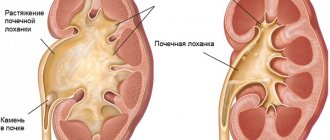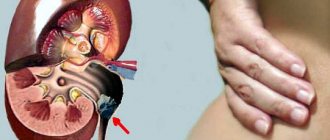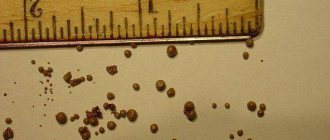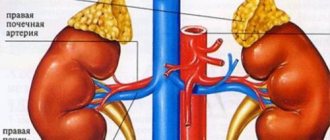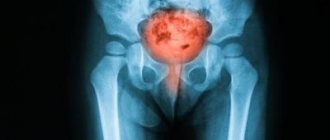Endocrinologist, nutritionist, nutritionist
Evdokimova
Elena Viktorovna
12 years of experience
Endocrinologist, nutritionist, nutritionist, member of the Russian Association of Endocrinologists. Member of the European Association for the Study of Diabetes (EASD)
Make an appointment
Adrenal cortex dysfunction, or Addison's disease, is a fairly rare disease that is expressed in a decrease or even complete cessation of the production of a number of hormones belonging to the groups of glucocorticoids and mineralocorticoids. The disease was first described more than a hundred and fifty years ago by the British physician T. Addison, in whose honor it received its name. Externally, Addison's “bronze disease” is often expressed in changes in skin pigmentation, often acquiring a bronze, brown or dirty gray tint. It is a progressive disease that affects both men and women equally.
General information
Addison's disease is a chronic failure of the adrenal cortex, manifested in a decrease or cessation of the secretion of hormones - mineralocorticoids and glucocorticoids ( aldosterone , cortisol , cortisone , corticosterone , deoxycorticosterone and other corticosteroids).
A deficiency of mineralocorticoid hormones leads to increased sodium excretion and decreased potassium excretion, mainly in urine, but also in sweat and saliva, while electrolyte imbalance causes severe dehydration, plasma hypertonicity, acidosis , decreased circulating blood volume, hypotension and even circulatory collapse . However, if the pathology is caused by decreased ACTH , electrolyte levels remain normal or moderately altered. Whereas a lack of glucocorticoids causes the following symptoms of Addison's disease: changes in insulin and impaired carbohydrate, protein and fat metabolism. As a result, carbohydrates necessary for life are formed from proteins, blood sugar levels decrease, glycogen deposited in the liver are depleted, which is expressed in general, muscle, and including myocardial weakness. Patients' resistance to viruses and infections, injuries and various types of stress . As failure develops, cardiac output decreases and circulatory failure occurs.
If the level of plasma cortisol is reduced, then ACTH synthesis is stimulated and the level of β-lipotropic hormone , which has melanocyte-stimulating activity, which, together with tropin, produces hyperpigmentation . People not only have bronze skin, but also mucous membranes. This means that secondary failure resulting from functional disorders of the pituitary gland does not manifest itself in the form of hyperpigmentation.
This endocrine disorder is quite rare - 4-6 people per 100 thousand in statistics from different countries. It was first described by the English physician, the father of endocrinology, Thomas Addison back in 1855 in the book “On the Constitutional and Local Consequences of Diseases of the Adrenal Cortex.”
Thomas Addison and his book
Symptoms in women, men, children
Nonspecific manifestations of Addison's disease lead to the fact that patients often receive treatment for similar diseases, take many medications for a long time and unsuccessfully until the doctor prescribes an examination of the adrenal glands. The most typical symptoms include:
- general weakness;
- rapid fatigue with minor physical exertion;
- weight loss;
- low blood pressure, fainting when changing body position (orthostatic hypotension);
- joint and muscle pain;
- increased craving for salty foods, loss of appetite, nausea;
- abdominal pain, vomiting, diarrhea;
- memory loss, lethargy, depression;
- neurosis, psychosis;
- tingling and numbness of the limbs.
The patient often cannot accurately indicate the onset of the disease, since its first manifestation is general weakness, which increases towards the end of the day (with neurasthenia, there is an improvement in well-being in the evening). Subsequently, motor activity decreases, speech becomes slow and the voice becomes quiet. Patients note an increase in weakness during infections and digestive disorders. Dehydration, nausea, loss of appetite, and vomiting lead to progressive weight loss.
Melanin deposition is among the most noticeable feature of Addison's disease . First, those parts of the body that come into contact with clothing, are exposed to the sun and already have color (for example, lips, nipple areolas) darken. Pigmentation then covers the entire skin.
Skin pigmentation in Addison's disease
This can be noticed by the darkening of fresh scars and an increase in the density of freckles. Exclusively in cases of autoimmune origin of the pathology, uncolored spots of vitiligo appear against the background of dark skin. One of the features is the deposition of calcium in the ear cartilage area.
Pathogenesis
There are many mechanisms of damage to the adrenal cortex, causing insufficiency in the production of hormones - hypocorticism , or their complete absence - acorticism . These include:
- autoimmune reactions (in 85% of cases) - antibodies to the adrenal cortex are synthesized in the body - immunoglobulins M , lymphoid infiltration, fibrosis and atrophy of functioning glandular cells occur;
- infections – introduced into the adrenal glands hematogenously, most often causing caseous necrosis and calcification;
- underdevelopment ( hypoplasia );
- oncology;
- genetic defects and diseases, such as hemochromatosis ;
- injuries;
- poisoning;
- impaired sensitivity or synthesis of adrenocorticotropic hormone (ACTH) as a result of ischemia, radiation, etc.
The structure of the adrenal glands
Hormones of the adrenal cortex and their significance
Hormones produced in the morphofunctional cortical layer of the adrenal glands are corticosteroids . Among them, the most active and important are:
- Cortisol is a glucocorticoid synthesized in the zona fasciculata of the cortex. Its main function is the regulation of carbohydrate metabolism, stimulation of gluconeogenesis and participation in the development of stress reactions. The conservation of energy resources is realized through the binding of cortisol to liver receptors and other target cells, which causes activation of glucose , its storage in the form of glycogen against the background of a decrease in catabolic processes in the muscles.
- Cortisone is a glucocorticoid, second in importance after cortisol, which can stimulate the synthesis of carbohydrates and proteins, inhibit the immune system, and increase the body's resistance to stressful situations.
- Aldosterone is the main human mineralocorticoid, synthesized in the zona glomerulosa of the cortex, under its action tissues are able to retain water and chlorides, sodium reabsorption and potassium excretion are enhanced, a shift towards alkalosis occurs, blood pressure and circulating blood volumes increase.
- Corticosterone is a less significant mineralocorticoid hormone; it also has glucocorticoid activity, although half that of cortisol, which is realized primarily in stimulating liver gluconeogenesis.
- Deoxycorticosterone is a minor, low-active mineralocorticosteroid hormone that can regulate water-salt metabolism and increase the strength and endurance of striated muscles.
Adrenal glands and endocrine regulation of the body
The adrenal glands are paired glands located in the retroperitoneal space above the kidneys and closely adjacent to them. They have different shapes - the left one is in the form of a hemisphere, the right one is in the form of a pyramid. The adrenal glands have two independent parts - the cortex and the medulla - and play a primary role in the regulation of endocrine processes.
The adrenal glands produce hormones:
- adrenaline and norepinephrine;
- cortisol and corticosterone;
- aldosterone;
- testosterone, estrogen.
The activity of the adrenal glands in producing hormones is regulated by the main endocrine organs - the hypothalamus, pineal gland and pituitary gland. When the concentration of hormones in the body decreases, a corresponding signal is sent to the brain - in response, the pituitary gland releases adrenocorticotropic hormone, under the influence of which the adrenal glands produce hormones.
The role of hormones produced by the adrenal glands is great. They are responsible for:
- maintaining optimal metabolism;
- establishing water-salt balance;
- lipid metabolism;
- optimization of the body's immune response;
- stabilization of blood pressure;
- stimulation of sexual desire, development of secondary sexual characteristics.
Classification
Depending on the mechanism of development of Addison's or otherwise bronze disease, the following are distinguished:
- primary insufficiency of the adrenal cortex - the basis of the pathology is damage to the glandular structures directly;
- secondary failure - as a result of a violation of the hypothalamic-pituitary system , which normally should stimulate the adrenal cortex.
Acute adrenal insufficiency is called hypoadrenal or Addison's crisis .
Features of Addisonian crisis
Addisonian crisis develops suddenly and can threaten a person’s life. Low concentrations of hormones (cortisol, aldosterone) in the bloodstream lead to loss of consciousness or psychosis, confusion, delirium, fever , severe vomiting and diarrhea , mineral and water imbalances, pain in the legs, lower back, abdomen, low blood pressure and even cause shock .
Possible complications and consequences
The most dangerous complication of Addison's disease is the development of Addisonian crisis, a life-threatening condition.
The reasons for its occurrence may be:
- stress (surgery, emotional stress, trauma, acute infectious diseases);
- removal of both adrenal glands without adequate hormone replacement therapy;
- bilateral adrenal vein thrombosis;
- bilateral embolism of the adrenal arteries;
- bilateral hemorrhage in the adrenal tissue.
Causes
Addison's disease and adrenal hypofunction can develop as a result of such processes and pathologies as:
- tuberculous, syphilitic, brucellosis lesions;
- purulent inflammation;
- decreased sensitivity or ACTH deficiency;
- taking exogenous corticosteroids, which provokes adrenal atrophy;
- development of non-hormone-producing tumors;
- congenital dysfunction;
- sarcoidosis;
- amyloidosis;
- drug therapy, for example, chlodatin , etomidate , spironolactone , ketoconazole , as well as barbiturates, steroidogenesis blockers.
Possible causes and mechanism of development of disorders
For primary failure, the reasons may be:
- autoimmune effects (idiopathic atrophy of the adrenal cortex), researchers from the USA believe that this includes up to 70% of cases of the disease, reports have appeared on the significance of AIDS;
- tuberculosis, syphilis;
- amyloidosis;
- underdevelopment of the glandular apparatus (hypoplasia);
- adrenal tumor or metastases to it;
- destruction of glandular tissue by toxic substances;
- genetic disorders in the process of synthesis of hormonally active substances;
- decreased sensitivity of adrenal tissue to “orders” from higher centers transmitted by adrenocorticotropic hormone of the pituitary gland (ACTH).
A tumor of the left adrenal gland compresses the glandular cells, causing their destruction
In secondary adrenal insufficiency (called hypothalamic-pituitary), the main factor in pathogenesis is damage to the anterior pituitary gland with a lack of adrenocorticotropic hormone. Its concentration in the blood is not enough to stimulate the glandular cells of the adrenal glands.
The reasons arise due to:
- local tumor in the brain stem or pituitary gland;
- consequences of ischemic attack, stroke;
- prolonged stressful situations;
- head injuries;
- radiation therapy of the brain for certain diseases;
- birth injuries in children in the first days of life;
- hormonal changes in women during pregnancy and menopause.
Addison's disease in such cases is often combined with decreased thyroid function, diabetes mellitus, and polyglandular deficiency syndrome (of all endocrine glands).
Symptoms of Addison's disease
The symptoms of Addison's disease are most acute under stress, when the sympathetic-adrenal system is depleted and the body experiences an increased need for glucocorticoids. The pathology develops slowly and may not be noticed for several months or even years, while it progresses, and the patient experiences:
- chronic fatigue;
- muscle weakness;
- increased irritability, anxiety, restlessness, tension and short temper;
- depressive disorder;
- thirst and need to drink plenty of fluids;
- strong heartbeat and development of tachycardia ;
- changes in taste in favor of salty and sour;
- flushes of nausea, dysphagia (impaired swallowing), digestive system disorders - vomiting, diarrhea, abdominal pain;
- loses weight and loses appetite;
- dehydration and excessive urine production ( polyuria );
- tetany, paralysis, tremors and convulsions , especially after consuming dairy products and the phosphates that accumulate as a result;
- paresthesia and deterioration of sensitivity of the limbs;
- decreased levels of glucose in the bloodstream ( hypoglycemia );
- decrease in the amount of circulating blood ( hypovolemia ).
In addition, arterial and, quite often, orthostatic hypotension develops. In women, from the reproductive system, adrenal depletion causes disruption of the menstrual cycle; in men, erectile dysfunction .
Important! One of the most specific manifestations of the disease described by Addison is hyperpigmentation of the skin of those areas that are exposed to solar radiation or greater friction. Dark spots - melasma - appear all over the body and even on the gums, which is why the pathology is also known as bronze disease. Only 10% of patients do not have this symptom and this pathology is called “White Addison” .
Another pathology is known, described by Addison and manifested in the form of yellowness of the integument - Addison-Birmer anemia , develops with a deficiency of vitamin B12 and is also called pernicious anemia or malignant anemia .
Addison-Birmer disease: symptoms and features
The pathology is based on atrophy of the gastric mucosa and cessation of secretion of Castle factor . Most often occurs in older people and people over 40 years of age. In addition to the autoimmune mechanism, the cause may be strict vegetarianism , cancer, helminthiasis, gastrectomy and enteritis .
Symptoms of Addison-Beermer disease include burning of the tongue, sensitivity, dryness and inflammation of the mucous membranes, fatigue, dizziness, migraines , shortness of breath , increased heart rate, daytime drowsiness and nighttime insomnia . At the same time, dyspeptic disorders are added - anorexia , diarrhea . Very often, patients seek medical help with significant anemia.
Addison-Biermer anemia is treated with injections of vitamin B12 , and is also aimed at normalizing hemoglobin .
Treatment
Treating the root cause
In most cases, the underlying causes of Addison's disease can be treated, for example, tuberculosis is treated with anti-TB drugs for at least 6 months.
If necessary, other infections can be treated with antibiotics or antifungal medications. Autoimmune diseases will also be treated, although they usually cannot be cured.
Treatment of Addison's disease
In most cases of Addison's disease, treatment will involve lifelong corticosteroid (steroid) replacement therapy. Corticosteroid medications are used to replace cortisol and aldosterone that the body no longer produces. They are usually taken in tablet form (orally) once or twice a day.
Synthetic glucocorticoids are used to replace cortisol. This is usually hydrocortisone . Other possible medications are prednisolone or dexamethasone , although these are less commonly prescribed.
Aldosterone is replaced with oral doses of a mineralocorticoid called fludrocortisone . Your doctor may also ask you to include salty foods in your daily diet, although this is not necessary if you are taking enough fludrocortisone.
Addison's disease should not affect the quality and length of life. Diet, exercise and daily routine can continue as usual. With medication, the symptoms of Addison's disease should completely disappear.
Medical bracelets
It is also recommended to wear a medical bracelet or necklace that lets people know that you have Addison's disease.
After a serious accident, such as a car accident, the body produces cortisol. This helps to cope with a stressful situation and the additional stress on the body resulting from a serious injury. Because the body cannot produce cortisol during the disease, you will need an injection of hydrocortisone to replace it and prevent Addisonian crisis.
If you wear a medical information bracelet, it will tell any medical personnel what your treatment needs are, your condition and what medications are required.
Medical bracelets or necklaces are pieces of jewelry that are engraved with your medical condition, in this case Addison's disease, as well as an emergency telephone number.
If you need to stay in hospital, the healthcare professionals responsible for your treatment should also know that you need steroid replacement medications throughout your treatment.
Adjusting medications
Medications may need to be adjusted at certain points to accommodate any additional stress on the body. For example, the dosage of the medication may need to be increased if the patient experiences one of the following conditions:
- illness or infection - especially if the high temperature is 37.5C;
- incident;
- needs surgery;
- takes part in some strenuous exercise.
Tests and diagnostics
To confirm Addison's disease you need to do:
- ultrasound examination of the adrenal glands to identify lesions, for example in tuberculosis ;
- blood test to determine the level of adrenal hormones (cortisol), ACTH, glucose, potassium, sodium, renin ;
- CT scan of the adrenal glands, which allows you to detect adrenal infarction, reduction in size, tumor metastases, amyloidosis;
- MRI of the brain to study the hypothalamic-pituitary region and detect destructive, tumor or granulomatous processes.
The basis for diagnosing Addisonian crisis is:
- a decrease in sodium concentration in the bloodstream below 130 mmol/l, excretion in urine - less than 10 g per day;
- an increase in potassium concentration in the bloodstream over 5 mmol/l;
- a drop in the ratio of sodium to potassium ions to 20 units (normally 32);
- low glucose levels;
- development of acidosis;
- high concentrations of urea , residual nitrogen in blood plasma tests.
Addisonian crisis
The adrenal glands are an organ that provides a response to any stress. During such periods, the need for cortisol increases sharply. If the response cannot provide the required amount of hormone, then a crisis develops. It refers to conditions that threaten life.
A crisis can occur due to unrecognized Addison's disease, an incorrectly selected dose of medication, or, what most often happens, uncorrected therapy due to stress, surgery, injury, pregnancy, bleeding, or infection.
Any concomitant disease, climate change, or temperature increase the risk of worsening adrenal insufficiency.
Manifestations of Addisonian crisis include:
- sharp pain in the lower back, abdomen, lower extremities;
- uncontrollable vomiting, diarrhea, copious urine output, leading to severe dehydration;
- drop in pressure to the point of shock;
- loss of consciousness, delirium, psychosis;
- convulsions.
Drop in blood pressure to the point of shock
Diet for adrenal insufficiency
Diet 15 table
- Efficacy: therapeutic effect after 2 weeks
- Timing: constantly
- Cost of food: 1600-1800 rubles per week
In addition to the fact that the patient needs to avoid hypothermia and stressful situations, a diet rich in carbohydrates is recommended. You need to add foods with a high amount of ascorbic acid (black currants, citrus fruits, rosehip decoction) and an additional 15-20 g of table salt per day to your diet.
To prevent hyperkalemia, it is better to limit the consumption of potassium-rich dried apricots, raisins, legumes, and potatoes.
Prevention
No specific preventive measures have been developed for bronze disease. Experts recommend strengthening the immune system, eating right and treating infections in a timely manner. Rules of caution include timely identification of pathologies that are the causes of Addison's syndrome.
The doctor should inform the patient about the doses of hormones that must be taken throughout life. It is important to see a doctor periodically to monitor the condition.
( 3 ratings, average: 5.00 out of 5)




